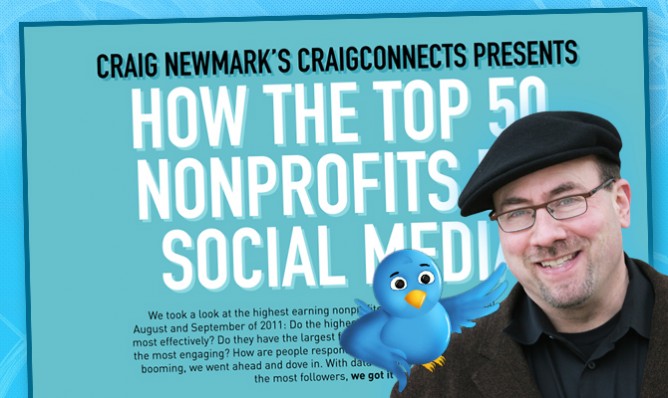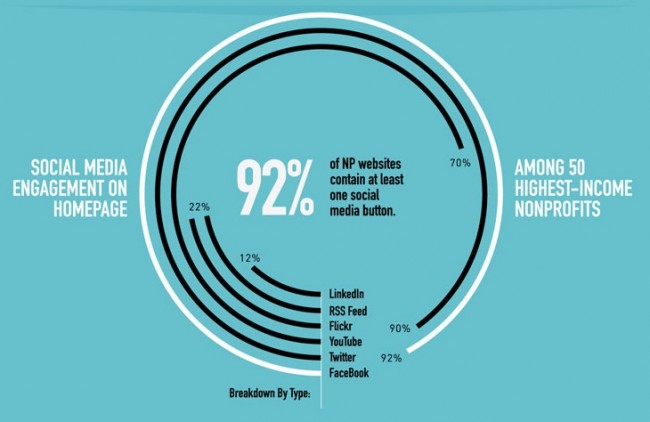Hold on, hold on! Before the grand reveal, a little contextual information. The Nonprofit Quarterly recently published the article, “Which causes do best on social media? That world according to Craig Newmark,” highlighting Newmark’s research on the United S tates’ top 50 not-for-profits (determined by Charity Navigator), their causes and which “do” social media the best. The leading not-for-profit organizations were grouped into categories of causes. Within these categories, the top 5 organizations were analyzed. The categories of causes include:
tates’ top 50 not-for-profits (determined by Charity Navigator), their causes and which “do” social media the best. The leading not-for-profit organizations were grouped into categories of causes. Within these categories, the top 5 organizations were analyzed. The categories of causes include:
- Animal
- Children
- Cultural
- Disaster Relief
- Environment
- Health
- Veterans and Military
- Women
To report his findings and analyses, Newmark and his team at Craigconnects produced two cleverly designed infographics, “Who Rules Social Media? A Look at Social Media Impact by Nonprofit Issues" and "How the Top 50 Nonprofits Do Social Media." In addition to data and nifty graphics, the reports shed light on the staffing of these organizations, revealing that of the 21 not-for-profit organizations Newmark and his researchers personally spoke with, all but one employed either a designated full-time or part-time social media staff person. Furthermore, Newmark's research indicates
...revenue does not increase a nonprofit's visibility and interactions in the social media world. Some of the most social media savvy organizations are in the bottom quarter bracket in terms of revenue, yet they are clearly active on social media. It's about fostering conversations and interactions, not money.
The winners of the most talkative category on Facebook and Twitter (in terms of Facebook posts, Tweets and responses) are the animal and environmental causes, averaging between 88-134 Tweets per week; the loser, the veteran and military category. The winner of the most talked about category on Facebook and Twitter was again, the animal cause and the losing causes, women and veterans. Curiously, though women are the dominant demographic using social media, the “women” cause is talked about the least…
How did the cultural cause fare? The top 5 cultural organizations considered in the report were the Smithsonian Institution, the Metropolitan Museum of Art, the New York Public Library, the Metropolitan Opera and the Lincoln Center for the Performing Arts. Averaging 8 Facebook posts and 32 Tweets a week, the cultural cause  ranked 5th and 4th respectively out of the 8 categories of causes. In terms of being talked about, the cultural cause ranked 5th both on Facebook and Twitter. Comparing revenues relative to social media activity of the top not-for-profit organizations, the Metropolitan Museum of Art ranked highly (considering its reported revenue of $319,054,654 is one of the lowest in the study). While the research and reports do not represent the cultural not-for-profit landscape in its entirety, excluding the hundreds of thousands not-for-profit cultural organizations that did not make the top 50 cut, the message is strong:
ranked 5th and 4th respectively out of the 8 categories of causes. In terms of being talked about, the cultural cause ranked 5th both on Facebook and Twitter. Comparing revenues relative to social media activity of the top not-for-profit organizations, the Metropolitan Museum of Art ranked highly (considering its reported revenue of $319,054,654 is one of the lowest in the study). While the research and reports do not represent the cultural not-for-profit landscape in its entirety, excluding the hundreds of thousands not-for-profit cultural organizations that did not make the top 50 cut, the message is strong:
… the bottom line is that your main concern should be to cultivate conversations, relationships, and interactions within your own specific community, whether it’s 2,000 or 200,000 people. Work to move “your people” up the ladder of engagement, based on their needs. But know it will take an investment of staff time and resources to achieve this. These are the keys to keeping up in the fast-paced arena of social networks.
Who not only maintains, but stimulates social media activity for your Facebook and Twitter account? Do you have a designated staff person or team regularly producing your online content? If not, can you delegate the responsibility to a committed volunteer or intern? How can not-for-profit arts and cultural organizations make their online social media presence stronger and more impactful to move from 5th place to 1st? With a know-how for attracting and retaining wide audiences in playhouses, galleries, museums, halls, theaters and the like, cultural not-for-profits should have a definite advantage when it comes to the same, but online. Take a look back at your own organizations Facebook and Twitter activity over the last few months, then share your thoughts, solutions and impressions of the research with us on Facebook or Twitter.





